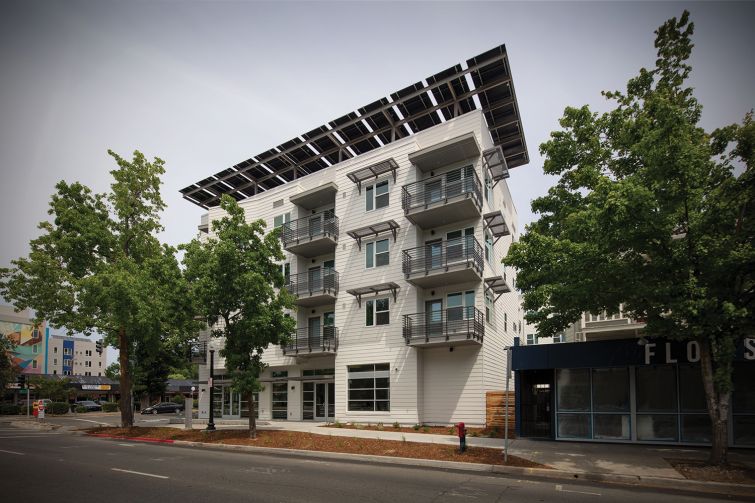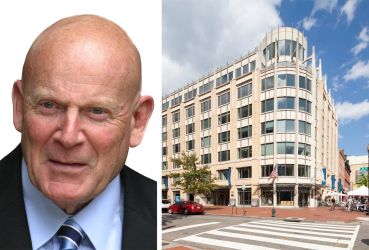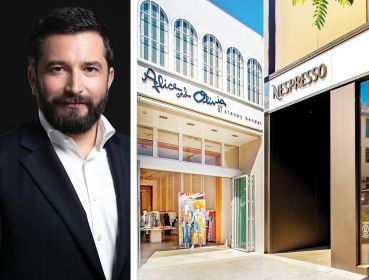LGBTQ Senior Housing: Developers and Investors Like the Numbers
The largest generation of out LGBTQ+ Americans ever is growing old, and senior housing builders are capitalizing. Challenges abound, though.
By Patrick Sisson June 21, 2023 10:58 am
reprints
In the fall of 2021, a housing ad began appearing in flyers, newspapers and community centers across Sacramento, Calif., offering a different view of senior living. Stock images of single-sex couples showcased what it would be like to live in a new LGBTQ-affirming community.
Part of the promotion campaign for Lavender Courtyard, a 53-unit affordable housing development meant for the city’s LGBTQ residents that opened in early 2022, the ad highlighted an accelerating national trend toward serving this historically marginalized community as it hits its golden years. The first LGBTQ-focused senior housing project in the U.S. probably dates from 25 years ago, and today the number of such units nationally could fit in no more than a handful of buildings. But things are changing.
“We hope that this does rally other developers to go down this path and, you know, help create more of these opportunities,” said Steven Root, communications manager of Mutual Housing California, the regional affordable housing developer behind Lavender Courtyard. “We hear from our residents that this has had a positive impact on their livelihoods. They feel like they’re at a place where they belong, where they can actually breathe.”
The ongoing demographic shift toward an older U.S. population, sometimes called “the silver tsunami,” has made the baby boomers the center of a lucrative rise in demand for senior housing. Roughly 10,000 boomers — the largest generation in American history until the millennials — are turning 65 every day now, and all will cross that threshold by 2030, according to census data. By some estimates, the nation will have 7 million LGBTQ+ people over 50 by 2030.
Amid the numerous variations on the theme — luxury urban rentals, Margaritaville-themed parties, and even college-adjacent communities — a growing niche of LGBTQ-centered developments cater to the largest generation of out Americans in history, one that has often fought to be recognized and that craves a place to be their authentic and vibrant selves.
“The LGBTQ+ community is really vast — nearly 7 percent of the nation is openly LGBTQ,” said Amy Simon, president of LGBT Senior Housing and Care. “The senior age group is growing exponentially, it’s become a large market. So, if you’re looking at it from a business, real estate, housing development perspective, you want to prepare for this group of customers.”
The Lavender Courtyard — which immediately filled up — was one of the first of its kind outside a large coastal city, and it speaks to the growing demand for such developments. But it also underscores some of the tricky aspects of truly serving the entire LGBTQ community. According to Root, community advocates had been pushing Mutual Housing for years to build Lavender Courtyard. Since it’s an affordable housing development, it needs to navigate fair housing laws, so it can’t discriminate. Instead of being LGBTQ-only, it’s marketed as a development that celebrates LGBTQ culture, and contains plenty of straight residents who embrace the development’s diversity.
Starting with the Palms of Manasota, which opened near Palmetto, Fla., in 1998, a number of different rental projects and housing communities have been created to cater to this demographic. Early examples of these types of senior developments include the Pryde complex in Boston, Town Hall Apartments in Chicago, and the John C. Anderson Apartments in Philadelphia, often located in neighborhoods central to their cities’ gay communities. As of 2021, there were more than 1,000 units of senior LGBTQ housing nationally, and currently 15 states have such developments, with more planned for Texas and Michigan. At least 32 affordable developments for gay seniors are operating or under development as of last November.
Developers see this space as one with potential, since even giants of the industry have embarked on their own projects. Related Companies and Atria Senior Living, in partnership with Welltower (WELL), perhaps the country’s largest senior housing owner, acquired 1001 Van Ness in San Francisco in 2019. (Atria declined to comment for this story.) An upscale resort-style apartment community for LGBTQ seniors, Living Out Palms Springs, will open in the expensive California desert community this year.
But cultural awareness is crucial to success. Simon said developers need to be aware of the community’s unique needs, and strive to create an affirming and safe environment. That often means welcoming the community’s diversity, and including space for allies and family to visit, as well as safe shared spaces and LGBTQ events programming. Inclusive visiting and rooming policies, as well as nondiscriminatory clauses, are key.
Root added that Lavender Courtyard spent time training staff on cultural awareness and sensitivity, as well as updating the language of leasing documents to reflect different pronouns and relationships. California, Massachusetts, New Jersey and Illinois have also passed laws to create specialized training programs for senior care staff. (The land and development costs for LGBTQ-focused senior housing is similar, if not identical, to costs in the sector in general.)
It’s also important to include spaces for social workers to help seniors access community services and provide important health and mental services, said Simon. This community has suffered a disparate amount of trauma, and higher health morbidities, from harassment, discrimination and even current government legislation. There’s also significant anxiety around aging and maintaining support and connections. An AARP study in 2020 found that 76 percent of older LGBTQ+ people expressed concern about having adequate social support as they age, while 73 percent do not have access to LGBTQ+-specific services for seniors.
“We believe every person, no matter their sexual orientation or gender identity, deserves access to high-quality, long-term care,” the American Health Care Association/National Center for Assisted Living, the country’s largest association for long-term and acute care providers, told Commercial Observer in a statement. “AHCA/NCAL has been an advocate of creating inclusive long-term care communities for LGBTQIA+ individuals by developing cultural competency training. Long-term care and senior living prides itself on delivering person-centered care, and that means we must honor each unique individual and foster inclusive communities.”
There haven’t been similar, recent developments in many red states, especially those that have enacted anti-trans and anti-gay legislation. “It’s a constant, cyclical quagmire for the community,” said Simon. She added that she thinks developers are talking about it more than actually building, especially in the affordable space, because of concerns that a change in presidential administrations might jeopardize ongoing projects.
There are also some challenging demographics and social factors at play, said Jesus Ramirez-Valles, a medical professor at the University of California-San Francisco, who wrote Queer Aging: The Gayby Boomers and a New Frontier for Gerontology. Many older gay Americans want to stay near gay meccas and neighborhoods in big coastal cities, he said, but they’re increasingly getting priced out and facing ageism. There are also many older gay Americans with plans to retire in Latin America or elsewhere. It’s more affordable, and avoids any cultural pushback in the U.S.
Ramirez-Valles also argues that there needs to be more study of, and senior housing built for, Black and Latino LGBTQ+ communities, and more effort for this nascent type of housing to truly reflect the entire community.
According to SAGE, a nonprofit that advocates for LGBTQ seniors, this community is twice as likely to live alone and four times less likely to have children, adding more weight to fears of being disconnected as they age, or facing discrimination as they get older. It makes access to more affordable options, and more inclusive communities, that much more vital.
“In my ideal world, those developments happen within the cities, within the LGBT communities,” said Ramirez-Valles. “And they offer incentive. But, otherwise, people will leave, because affordability is issue No. 1.”


